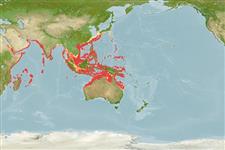Environment: milieu / climate zone / depth range / distribution range
Οικολογία
Θαλασσινό(ά) βενθικό(ς); εύρος βάθους 18 - 383 m (Ref. 5222). Tropical; 36°N - 24°S, 36°E - 155°E (Ref. 5222)
Indo-West Pacific: spotty distribution from the Red Sea to Japan and Papua New Guinea. Referred to as Epinephelus morrhua morrhua in Japan (Ref. 5978).
Μέγεθος / Βάρος / Age
Maturity: Lm ? range ? - ? cm
Max length : 70.0 cm SL αρσενικό/απροσδιόριστο; (Ref. 4787)
Ραχιαίες άκανθες (συνολικά) : 11; Μαλακές ραχιαίες ακτίνες (συνολικά) : 13 - 15; Εδρικές άκανθες: 3; Μαλακές εδρικές ακτίνες: 8. Distinguished by the following characteristics: tan body color with 5 oblique dark-edged pale bands; dark bands with scattered small black spots and pale blotches, especially dorsally; pale interspaces with small dark brown spots, mainly arranged in series along the middle of the interspaces; adults with dark brown line from the lower edge of the eye to the edge of the subopercle; faint dark band along the maxillary groove and continuing to the edge of the interopercle; dorsal fin and caudal fin covered with small dark spots; juveniles dark brown with black-edged pale brown bands enclosing numerous small black spots; body depth contained 2.6-3.0 times in SL; head length 2.1-2.3 times in SL; nearly flat interorbital, dorsal head profile slightly convex; 2-5 distinctly enlarged serrae on preopercle angle; upper edge of operculum almost straight; adults posterior nostril diameter 2-3 times that of anterior nostrils; maxilla reaches to or past vertical at rear edge of eye; 2 rows of teeth on midlateral part of lower jaw (Ref. 89707).
Adults are found at depths between 80 to 383 m; juveniles in 18 to 20 m (Ref. 5222), over hard substrates (Ref. 89707). The species is apparently rare (Ref. 5222).
Life cycle and mating behavior
Γεννητική Ωρίμανση | Αναπαραγωγή | Γεννοβολία | Αβγά | Γονιμότητα | Προνύμφες
Heemstra, P.C. and J.E. Randall, 1993. FAO Species Catalogue. Vol. 16. Groupers of the world (family Serranidae, subfamily Epinephelinae). An annotated and illustrated catalogue of the grouper, rockcod, hind, coral grouper and lyretail species known to date. Rome: FAO. FAO Fish. Synop. 125(16):382 p. (Ref. 5222)
IUCN Red List Status (Ref. 130435: Version 2024-2)
Threat to humans
Harmless
Human uses
αλιεία: περιορισμένης εμπορικότητας
Εργαλεία
Special reports
Download XML
Διαδικτυακές πηγές
Estimates based on models
Preferred temperature (Ref.
123201): 16.9 - 27.8, mean 23.7 °C (based on 783 cells).
Phylogenetic diversity index (Ref.
82804): PD
50 = 0.5000 [Uniqueness, from 0.5 = low to 2.0 = high].
Bayesian length-weight: a=0.01778 (0.01025 - 0.03084), b=3.11 (2.97 - 3.25), in cm total length, based on LWR estimates for this species & Genus-body shape (Ref.
93245).
Τροφικό Επίπεδο (Ref.
69278): 3.8 ±0.61 se; based on food items.
Ελαστικότητα (Ref.
120179): Χαμηλό, ελάχιστος χρόνος για διπλασιασμό πληθυσμού 4,5 - 14 έτη (Fec = 55,838).
Fishing Vulnerability (Ref.
59153): Moderate to high vulnerability (54 of 100).
